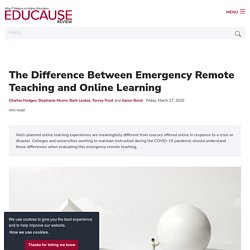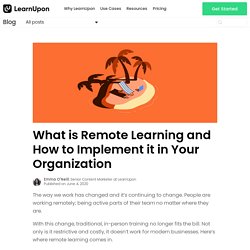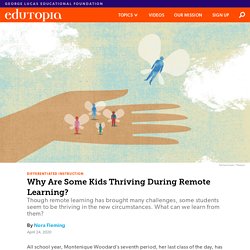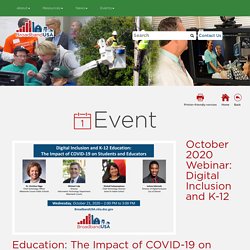

Handout EmergencyRemoteLearning. The Differences Between Online Learning vs. Emergency Remote Teaching. There is a difference, Brown says, between true online education and the sudden, stopgap shift in which higher education institutions are currently engaged.

What’s occurring at present, he explains, is a rush job — an effort to mitigate the losses students and universities might experience were they forced to completely abandon a semester’s worth of work. Emergency remote teaching environment: a conceptual framework for responsive online teaching in crises. The Difference Between Emergency Remote Teaching and Online Learning. Well-planned online learning experiences are meaningfully different from courses offered online in response to a crisis or disaster.

Colleges and universities working to maintain instruction during the COVID-19 pandemic should understand those differences when evaluating this emergency remote teaching. Due to the threat of COVID-19, colleges and universities are facing decisions about how to continue teaching and learning while keeping their faculty, staff, and students safe from a public health emergency that is moving fast and not well understood.
Many institutions have opted to cancel all face-to-face classes, including labs and other learning experiences, and have mandated that faculty move their courses online to help prevent the spread of the virus that causes COVID-19. The list of institutions of higher education making this decision has been growing each day. The temptation to compare online learning to face-to-face instruction in these circumstances will be great. Table 1. M. What is Remote Learning? Excerpted from "The Just in Time Playbook for Remote Learning" by Dr.

Kecia Ray The officially identified pandemic of COVID-19 is impacting more than 376 million students worldwide (see UNESCO’s website for updated reports of school closures). The number of students that will experience education disruption grows daily. This outbreak comes to the U.S. at the onset of state assessments and spring breaks, which means state departments of education will need to determine what guidance to offer districts related to state testing and attendance.
This article provides an explanation of remote learning, describes the structured elements necessary for its success, and includes many resources for schools and higher education institutions to get started today. What is Remote Learning and How to Implement it in Your Organization. The way we work has changed and it’s continuing to change.

People are working remotely; being active parts of their team no matter where they are. With this change, traditional, in-person training no longer fits the bill. Not only is it restrictive and costly, it doesn’t work for modern businesses. Here’s where remote learning comes in. Remote training gives your organization the power to train each and every member of staff regardless of location, be it in one of your worldwide offices or in their home office.
What is remote learning? Remote learning, also referred to as distance learning, gives learners who aren’t in a physical location for in-person education, access to online training materials. It’s become a go-to training method for growing businesses, as it enables them to train every employee on the necessary topics regardless of location. For example, at LearnUpon, our team is spread across four time zones. How to run an impactful remote learning program 1. 2. 3. 4. Why Are Some Kids Thriving During Remote Learning? We’ve been hearing that a lot.

Increasingly, teachers in our audience are reporting that a handful of their students—shy kids, hyperactive kids, highly creative kids—are suddenly doing better with remote learning than they were doing in the physical classroom. “It’s been awesome to see some of my kids finally find their niche in education,” said Holli Ross, a first-year high school teacher in northern California, echoing the sentiments of dozens of teachers we’ve heard from. That’s not to say it’s the norm. Many students are struggling to adapt to remote learning: Digital access and connectivity remain a pervasive equity issue; stay-at-home orders have magnified existing problems in familial dynamics; and, universally, teachers and students grapple with how to replicate the engagement and discourse from an in-person classroom. The Benefits of Self-Pacing On average, the typical high school student starts school at 8:00 a.m.
Time to Rethink the Overextended Kid Lowering the Stakes. October 2020 Webinar: Digital Inclusion and K-12 Education: The Impact of COVID-19 on Students and Educators. Date:Wednesday, October 21st, 2020Time:02:00 PM EDTType Of Event: Webinar Description: The rapid shift to online learning can be a challenge for students, families, and educators – particularly in low-income, rural, and tribal communities.

As the new school year begins, the longstanding issue of digital inclusion stands in sharp relief. Join BroadbandUSA on October 21st to learn how communities are helping students get connected, assisting parents and caregivers gain the skills to help their children navigate online learning environments, and transitioning educators to online teaching. This panel will explore the challenges that communities and schools are facing, their innovative solutions to keep students connected, and their plans to transition from short-term solutions to long-term sustainable programs.